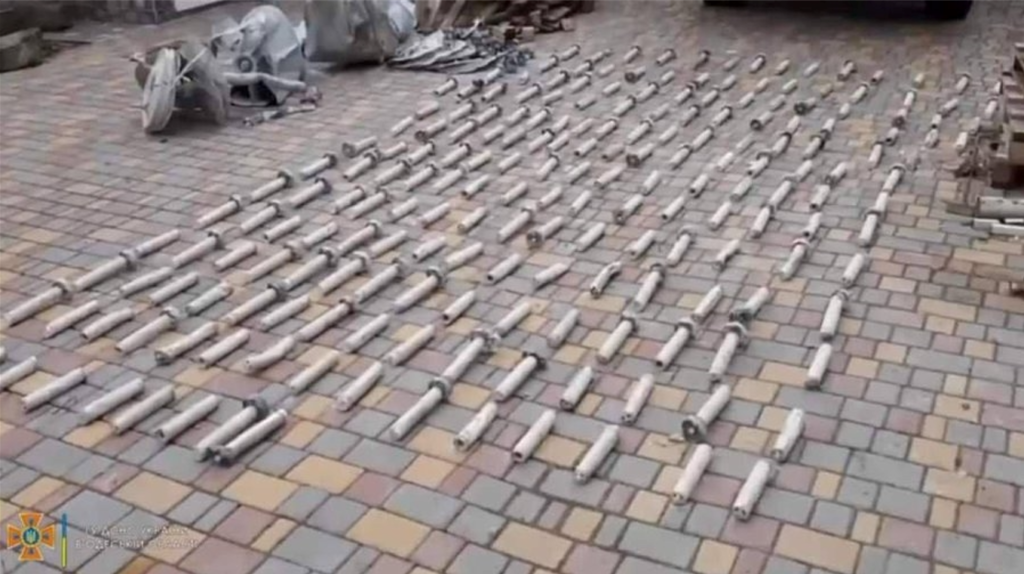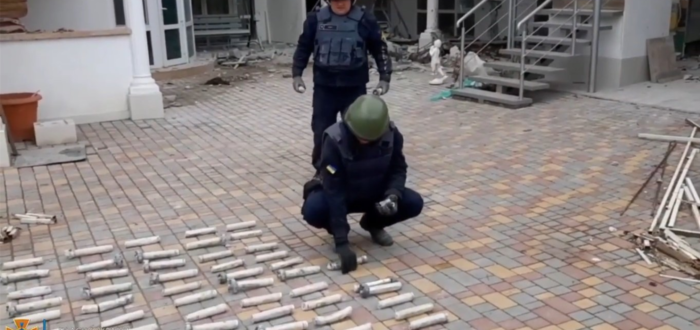N.R. Jenzen-Jones & Charlie Randall
Editor’s Note: This article is based primarily on a 2016 ARES article documenting the use of the PTAB-1M submunition in Syria.
A video posted on Facebook by the State Emergency Service of Ukraine (DSNS), Odessa Region, shows PTAB-1M (ПТАБ-1М; ‘Protivo Tankovaya Avia Bomba’, or ‘anti-tank aviation bomb’) submunitions have been employed by Russian forces in Ukraine. The PTAB-1M is of the high explosive anti-tank (HEAT) type, and was developed in the Soviet Union by what is now RPO Bazalt between 1985 and 1988. It is easily identified by its distinctive cylindrical shape and helical tailfin arrangement, and was previously documented in Syria (as described in a forthcoming ARES report). However, its apparently high dud rate—demonstrated both in Ukraine and Syria—implies that the use of this submunition may pose a significant UXO threat.

In addition to submunitions, which ordnance specialists are shown recovering, the video depicts the remnants of the carrier munition, the tail and casing of which (see Figures 1 & 2) indicate it is an RBK-500 (Razovaya Bombovaya Kasseta; ‘single-use cassette bomb’) series munition. Unlike many of the other carrier munitions documented in Ukraine by ARES and others thus far—which have been, by and large, powered munitions (i.e., rockets or missiles)—the RBK-500 is notably an aerial bomb. It is designed to disperse submunitions over a wide area, which makes it easier to target moving armoured vehicles. In addition to the PTAB-1M submunition, the RBK-500 series of aerial bombs can also carry other submunitions, such as the the SPBE ‘self-guided’ anti-tank submunition (a type of ‘sensor-fuzed’ submunition) or the AO-2.5RT high-explosive fragmentation (HE-FRAG) anti-personnel submunition.

PTAB-1M submunitions appear to have been produced in at least two iterations, with very minor exterior design differences. They are most commonly contained within RBK-500 and RBK-500U carrier munitions, but can also be dispensed from BKF cassettes, contained within KMGU series universal dispensers. When the submunition has been loaded into the RBK-500, the complete aerial bomb is known as the ‘RBK-500 PTAB-1M’. It contains 268 submunitions, arranged in three ‘forward’ layers of 80 submunitions each, as well as one ‘rear’ layer of 28 submunitions towards the tail end of the munition (see Figure 3).

After release from the aircraft, the RBK-500-series cluster munition employs a time fuze to determine the point at which it functions. This fuze initiates an ejection charge, separating the submunitions from the cargo munition. After the submunitions separate, they are dispersed via centrifugal force and fall toward the ground. At this time, the interlocking sections of the submunitions’ tail unit spring open to form a ring aerofoil. This operation disengages the safety devices within the fuze of the submunition. The PTAB-1M is designed to strike the top armour of armoured fighting vehicles (which is often thinner than a vehicle’s frontal or side armour) and is capable of penetrating a minimum of 200 mm of rolled homogeneous armour equivalent (RHAe). These HEAT submunitions employ a shaped charge that is initiated by a piezoelectric point-impact, base-detonating (PIBD) fuze. Additionally, they are equipped with a self-destruct mechanism, which U.S. EOD sources believe to be about 20–40 seconds.

In the case of this recent use in Ukraine, most or all of the PTAB-1M submunitions seemingly failed to function upon impact. In fact, from an examination of the visible submunitions in Figure 1 alone, it can be discerned that at least 80% of the 268 submunitions are present. The condition of the munition and submunitions in this Ukraine example suggest that the bomb likely failed to function, and the entire munition struck the target without dispensing (or, in all likelihood, arming) its submunitions. As ARES and other organisations have noted, UXO generated by submunitions in Ukraine already poses a serious ongoing threat to the civilian population. As more submunitions are documented in civilian areas—those shown here are believed to have struck a hotel—this risk is exacerbated.
Technical Characteristics
RBK-500 PTAB-1M cargo bomb
Overall length: 1,954–1,955 mm
Diameter: 450 mm
Weight: 427 kg
Number of submunitions: 268
PTAB-1M submunition
Length: 260 mm
Diameter: 42 mm
Weight: 944 g
Fuze: PIBD with SD feature (suspected to be 20–40 seconds)
Armour penetration: 200 mm RHA or greater
Sources
ARES (Armament Research Services). n.d. Conflict Materiel (CONMAT) Database. Confidential. Perth: ARES.
Collective Awareness to UXO. n.d. ‘PTAB 1M Submunition’. <https://cat-uxo.com/uxo-types/submunitions/ptab-1m-submunition>.
Jenzen-Jones, N.R. 2021. Munitions Employing Sensor-fuzed Submunitions: Do they Comply with the Convention on Cluster Munitions? Special Report 4. Perth: Armament Research Services (ARES). <https://armamentresearch.com/wp-content/uploads/2021/10/ARES-Special-Report-No.-4-Munitions-Employing-Sensor-fuzed-Submunitions.pdf>.
Lyamin, Yuri, & N.R. Jenzen-Jones. 2016. ‘PTAB-1M submunitions documented in Syria’. The Hoplite. 2 March. <https://armamentresearch.com/ptab-1m-submunitions-documented-in-syria/>.
Remember, all arms and munitions are dangerous. Treat all firearms as if they are loaded, and all munitions as if they are live, until you have personally confirmed otherwise. If you do not have specialist knowledge, never assume that arms or munitions are safe to handle until they have been inspected by a subject matter specialist. You should not approach, handle, move, operate, or modify arms and munitions unless explicitly trained to do so. If you encounter any unexploded ordnance (UXO) or explosive remnants of war (ERW), always remember the ‘ARMS’ acronym:
AVOID the area
RECORD all relevant information
MARK the area from a safe distance to warn others
SEEK assistance from the relevant authorities

